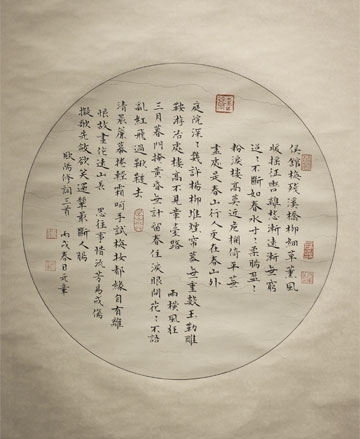Shapes in Time: Contemporary Chinese Calligraphy
–
In his meditation on the history of material culture, The Shape of Time, George Kubler describes the structure of history as shaped by “primary objects” and their “replicas”—the copies, quotations, or re-appropriations of these primary objects over time. These recurrences constitute human culture, as people seek to define and express themselves through meaningful, commonly accepted artistic vocabularies.

Fu Yuanzhang (b. 1968), Three Songs by Ouyang Xiu, 2006, hanging scroll, ink on paper. Purchased with funds provided by the Barbara P. and Robert P. ’64 Youngman Acquisition Fund for Asian Art.
The works included in this installation, all drawn from the Museum collection, demonstrate the vitality of Chinese calligraphy as a contemporary art form. The title of the exhibition, Shapes in Time, acknowledges both the literal meanings of these texts and the abstract, formal configurations of their inscriptions.
Calligraphy, or “beautiful writing,” is among the most highly esteemed arts in China. A vehicle for the preservation and transmission of texts, it also serves as a medium through which literate individuals can connect with their predecessors, two hands separated by centuries tracing the same words. The works also illustrate a variety of calligraphic styles. From the highly regular and clearly legible, to the cursive and abbreviated, individual characters can both reveal and obscure specific meaning. The forms of characters, abstract traces left by brush and ink, are as essential to these works of art as their literal readings.
In addition to the nine calligraphies and several related objects that are the focus of the installation, other works on view in the gallery that incorporate the written word are marked with the character wen. Essentially translated as “literature,” “culture,” and “writing,” the character wen may also mean “to depict,” and “to embellish or adorn.” It encompasses not only writing, but also books, ideas, and doctrines.
This exhibition has been organized by Stephen Whiteman in conjunction with his course, “From Mao to Now: Contemporary Chinese Art, 1976 to the Present.” Additional research and translations of the texts have been generously provided by faculty members Xu Weihe, Don Wyatt and Rebecca Handler-Spitz, with further assistance from Zhang Yinglei and Xu Dongfeng.
